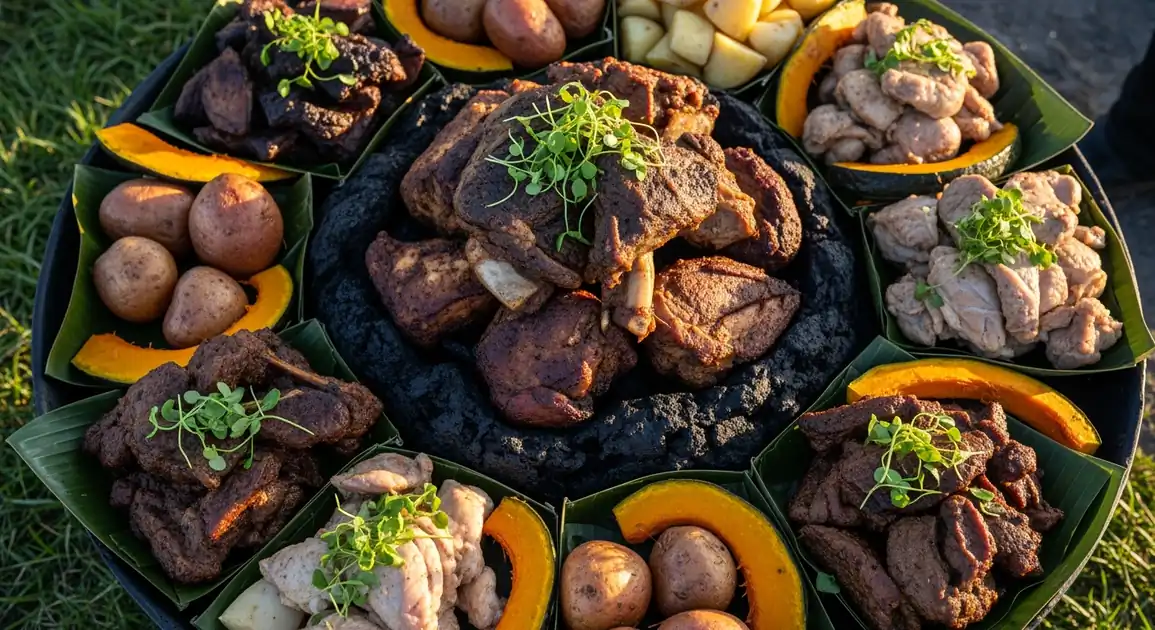Hangi
Hāngī

Description
Hangi is central to New Zealand's indigenous food heritage, with regional variations found throughout the country. While traditionally a Māori cultural practice, hangi has become an important part of broader New Zealand culinary identity, particularly for celebrations and special events. The most authentic experiences are found in areas with strong Māori cultural presence.
Dietary Information
Serving information
Serving style
Traditionally served communally on large platters for sharing, though tourist experiences often provide individual portions. Food is typically arranged with meats and vegetables separated for guests to select their preferences.
Quick facts
Most hangi experiences run to set schedules, typically 12 PM (lunch) or 6 PM - 7 PM (dinner). The full experience including cultural elements usually lasts 2-3 hours.
Safety Tips
What to Look For
-
Experienced hangi masters overseeing the process
Proper hangi requires specific knowledge of cooking times, temperatures, and techniques. Experienced practitioners ensure food safety and quality.
-
Steam rising when hangi is uncovered
Visible steam indicates the food has reached and maintained proper cooking temperature throughout the process.
-
Meat that falls off the bone easily
Properly cooked hangi meat is very tender. Resistance when pulling meat apart can indicate undercooking, particularly concerning for chicken and pork.
-
Food served hot immediately after unearthing
Properly cooked hangi should be served promptly after uncovering to maintain safe temperatures and prevent bacterial growth.
-
Clean, food-grade wrapping materials
Traditional leaves or modern foil/cloth should be clean and suitable for food contact to prevent contamination.
What to avoid
-
Pink or bloody meat, especially chicken or pork
Meat should be thoroughly cooked with no pink remaining, particularly for chicken and pork to avoid foodborne illness.
-
Undercooked vegetables (especially potatoes)
Hard vegetables indicate insufficient cooking time/temperature, suggesting the entire hangi may be undercooked.
-
Cold spots in the food
Uneven temperatures can indicate problems with the cooking process. All portions should be consistently hot.
-
Hangi that's been held at room temperature for extended periods
Food should be served promptly after unearthing. Extended holding at ambient temperature can allow bacterial growth.
-
Restaurants claiming 'hangi' but using conventional ovens
While not a safety concern, conventional oven cooking lacks the authentic flavor and may not reach the same cooking temperatures as traditional methods.
Price information
Price range
Budget tips
- Cultural centers in less touristy areas often offer better value (NZ$25-45 per person).
- Group bookings usually receive discounted rates.
- Food festivals sometimes offer smaller hangi portions for NZ$15-20.
- Complete cultural experiences with performances justify higher prices (NZ$80-150).
Value indicators
- Traditional in-ground cooking method using heated rocks.
- Cultural performance or educational component included.
- Generous portion sizes with multiple meat options.
- Involvement of local Māori community or iwi (tribe).
- Opportunity to watch part of the preparation or uncovering process.
Where to Find This Dish
Geothermal Regions
Especially in Rotorua, where natural geothermal activity is incorporated into the cooking process.
Te Puia, Whakarewarewa Village, Mitai Maori Village
Evening
Cultural Centers (Marae)
Traditional meeting grounds throughout the country offering authentic cultural experiences.
Waitangi Treaty Grounds (Northland), Te Papa Marae (Wellington)
Prearranged times, typically midday or evening
Tourism Centers
Major tourist destinations offer commercial hangi experiences.
Skyline Queenstown, Hobbiton Movie Set (special events)
Evening
Vendor Tips
- Ask if they use the traditional in-ground method or modern adaptations.
- Book in advance - authentic hangi experiences often sell out, especially in high season.
- Look for experiences that include explanation of the process or viewing of the preparation.
How to Order
Regional Variations
-
Traditional Earth Oven Hangi
(Hāngī Tūturu)
The authentic method using an earth pit with heated volcanic rocks, wet sacking, and soil covering. Food is wrapped in leaves or foil packages. This method produces the distinctive earthy, smoky flavor.
-
Geothermal Hangi
(Hāngī Ngāwhā)
Found primarily in Rotorua and geothermal areas, this method utilizes natural steam vents for cooking, imparting a unique mineral-rich flavor profile influenced by the geothermal environment.
-
Steam-Cooker Hangi
(Hāngī Whakakoropupū)
A modern adaptation using above-ground steam cookers or special hangi units. More convenient but lacks the earth-contact flavor of traditional methods. Common in restaurants and commercial operations.
-
Hangi Box/Kāpura
(Pouaka Hāngī/Kāpura)
A portable metal container with heated elements used for home hangi. Gas-heated stones provide some traditional flavor while being more accessible for everyday cooking.
-
Rewena Hangi
(Hāngī Rewena)
Includes traditional rewena bread (potato-fermented Māori bread) either cooked alongside or served with the main hangi components.
-
Fusion Hangi
(Hāngī Whakaranu)
Contemporary interpretations incorporating non-traditional ingredients or techniques, such as international spices, wine infusions, or modern presentation styles while maintaining the earth-oven cooking method.
Cultural context
History
Hāngī has been a cornerstone of Māori cooking for over 700 years, brought to Aotearoa (New Zealand) with Polynesian settlers. Traditionally used for communal cooking at important gatherings, the technique maximized fuel efficiency while producing large quantities of food. Special pit sites became established at marae (meeting grounds) for regular use. While historically wrapped in leaves from native plants like harakeke (flax), modern adaptations often use foil and cloth. Despite contemporary conveniences, many communities maintain traditional methods for cultural preservation.
Local significance
Hangi represents more than just food in Māori culture - it symbolizes community, hospitality, and connection to tradition. Preparing hangi is a communal activity that brings people together, with specific roles and responsibilities reflecting social structure.
Eating customs
- Food may be eaten with hands in traditional settings.
- Sharing from communal platters is common in authentic contexts.
- All parts of the meal should be respected, including simple vegetables which are key components.